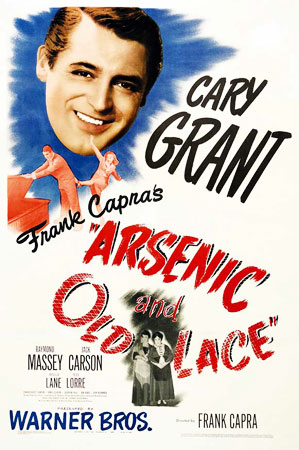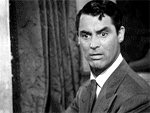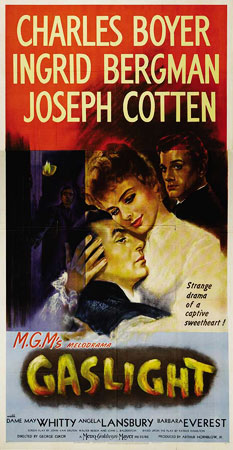Triple Feature Feature
I don't know about you, but when the days start getting shorter and the air chillier, but I want some sort of thrilling, exciting story. Something that makes you jump out of your skin just a bit. Nothing too graphic ('cause I have to watch through my fingers... at best), but enough to give me a jolt. And, with Halloween just around the corner, fright is very comfortably in the air.
For most modern viewers, classic films don't often fall into the "scary" category. Let's face it: technology has allowed us to create some really wonderfully terrifying screen images that make even the best efforts of years past look weak and sometimes funny. So, we're not going to go with any sort of monster movies, that are so popular this time of year. Instead, this month I'm going to bring you some really great psychological thrillers that don't always stay so psychological.
And, if you're clever, you'll be able to pick out another theme that connects these three films.
Arsenic and Old Lace (1944)
(Directed by Frank Capra. Starring Cary Grant, Priscilla Lane, Raymond Massey, Peter Lorre, Josephine Hull, Jean Adair, and John Alexander.)
 Movies made from successful stage plays aren't all that uncommon. Movies made from successful stage plays starring the original actors is not extraordinary. A movie made from a successful stage play, starring some of the original actors, filmed during the play's original run, and prohibited from being released until the play closes? Well, now, that's something entirely different, and it's called Arsenic and Old Lace.
Movies made from successful stage plays aren't all that uncommon. Movies made from successful stage plays starring the original actors is not extraordinary. A movie made from a successful stage play, starring some of the original actors, filmed during the play's original run, and prohibited from being released until the play closes? Well, now, that's something entirely different, and it's called Arsenic and Old Lace.
On Broadway, Arsenic and Old Lace was a huge hit when it opened in 1941. Warner Bros. bought the film rights to it and even got three of the principal actors from the play to appear in their movie. The only caveat was that they couldn't actually release the picture until the play finished its New York run. A little odd, perhaps, but the studio agreed and finished filming their version before the year was out. Of course, they didn't anticipate the play running until the middle of 1944!
Arsenic and Old Lace introduces us to Mortimer Brewster (Cary Grant), a writer and theater critic. He's got a brother named Teddy who believes he's Teddy Roosevelt, complete with a bugle and a Panama Canal to build, and two spinster aunts, Martha (Jean Adair) and Abby (Josephine Hull). He's also got another brother, Jonathan (Raymond Massey), who unsettles everyone. It's Halloween, and Mortimer just married the girl-next-door Elaine (Priscilla Lane). While his aunts start planning a little evening celebration of Mortimer's and Elaine's nuptials, Mortimer discovers a body in the window seat. A dead one. And things get even worse when Jonathan shows up with mysterious Dr. Einstein (Peter Lorre). Can Mortimer ensure that his family stays out of trouble?
There is a lot about this movie that's broad. Very, very broad. And a lot of the broadness comes from Cary Grant. He plays Mortimer very... big. But, it's not a bigness that's really out of place. Mortimer has to deal with a lot this particular Halloween night, so it's no wonder he overreacts sometimes. Or talks to himself in a sort of distracted way. Or makes a boggle face. No, really, he makes a *boggle* face. See?

Cary Grant's boggle face aside, he's really the madcap icing on the crazy cake, because the performances in the movie are wonderful. As the spinster aunts, Jean Adair and Josephine Hull are wonderfully little batty, like they've spent too long tucked away in their own little world, with a touching sweetness about them. Raymond Massey's Jonathan is creepy and weirdly child-like. Peter Lorre makes Dr. Einstein rather sympathetic. And there are so many wonderful character actors in this movie, some of the best of the era, including Jack Carson, Grant Mitchell, James Gleason, and the imitable Edward Everett Horton. Their roles may not be big roles, but they really hit it out of the proverbial park.
Make no mistake, though. While this movie is definitely a comedy, it does have its thrilling moments. It may not be exactly scary, but it can produce some chills between the guffaws.
Gaslight (1944)
(Directed by George Cukor. Starring Charles Boyer, Ingrid Bergman, Joseph Cotten, and Angela Lansbury.)
 If you've heard the phrase "to gaslight someone," you probably can guess what happens in this movie; if you've never heard that particular phrase, well, you're in for a treat. (Actually, even if you know the phrase, you should still watch this movie, because it's great.)
If you've heard the phrase "to gaslight someone," you probably can guess what happens in this movie; if you've never heard that particular phrase, well, you're in for a treat. (Actually, even if you know the phrase, you should still watch this movie, because it's great.)
Based on a stage play called Angel Street, Gaslight is the story of Paula (Ingrid Bergman), the niece of a famous opera singer who was murdered when young Paula was living with her. Paula grows up and marries the charming pianist Gregory Anton (Charles Boyer), and together they move into Paula's aunt house, the scene of the crime and now Paula's property. Everything seems wonderful at first, only Paula starts forgetting things, and she doesn't trust their new maid Nancy (Angela Lansbury); meanwhile, Gregory won't let her have visitors, for her own good. Then, a mysterious man named Brian Cameron (Joseph Cotten) shows up with an intense interest in Paula, who insists she's never met him before. Is the man a stranger, or is Paula losing her mind?
The best way to describe this movie is a melodramatic gothic horror story. It's not scary in the bloody, stuff jumping out at you sort of way, but it's certainly unsettling. It even looks dark and gothic; it's set in London, so naturally the fog is turned up to eleven to add to the atmosphere. And, it can be difficult to decide who to identify with, which makes it that much more interesting as a viewer.
Gregory seems like he's only got Paula's welfare in mind, but he reacts in oddly disturbing ways. Cameron seems like he could be a good guy, but he's weirdly obsessive. Nancy is enjoyable to watch, but she's not exactly a sympathetic character; in fact, she's rather saucy. And Paula, well... she's tortured, and that's not who you want to identify with. So, in terms of who we as the audience connect with, there's no real white knight here, which makes for a fascinating viewing experience.
Something must be said about Ingrid Bergman's performance here, which, incidentally, won her an Academy Award. She plays through a lot of different character beats here, and she does so with utter perfection. Her young, fresh-in-love Paula is charming. Her hesitant, uncertain Paula is touching. Her descent into madness is heart-wrenching and pitiable; you don't want to think that she's crazy, but she certainly seems to be. And, her final scene is, in a word, amazing. It's the sort of scene that screams "Oscar bait!" to modern audiences, but it doesn't play that way; it's just a woman confronting her demons, and it's mesmerizing.
Gaslight shouldn't scare you out of your skin, but it'll give you an excellent tale of horror to occupy your autumnal nights.
Wait Until Dark (1967)
(Directed by Terence Young. Starring Audrey Hepburn, Alan Arkin, Richard Crenna, Efrem Zimbalist Jr., Jack Weston, and Julie Herrod.)
Of the three movies I'm talking about this issue, this is the one you want to watch with the lights out, to get the full effect. It's exciting, scary, and terrifying.
 Wait Until Dark is about Susy Hendrix (Audrey Hepburn), a recently-blind woman, and her husband Sam (Efrem Zimbalist Jr.), a photographer; Susy spends her days in blind school, and, with occasionally help from Gloria (Julie Herrod), the landlady's daughter, is working to become the best blind lady in the city. One day, Sam is on assignment when Susy is visited by Mike Talman (Richard Crenna), who is there when Mr. Roat (Alan Arkin) bursts in, accusing Sam of having an affair with Mrs. Roat and searching for a special doll of hers. After a detective Carlino (Jack Weston) gets involved, Mike helps Susy look for the doll, but to no avail. But, Susy begins to suspect that Mike's got another reason to help her. Who can Susy turn to for help?
Wait Until Dark is about Susy Hendrix (Audrey Hepburn), a recently-blind woman, and her husband Sam (Efrem Zimbalist Jr.), a photographer; Susy spends her days in blind school, and, with occasionally help from Gloria (Julie Herrod), the landlady's daughter, is working to become the best blind lady in the city. One day, Sam is on assignment when Susy is visited by Mike Talman (Richard Crenna), who is there when Mr. Roat (Alan Arkin) bursts in, accusing Sam of having an affair with Mrs. Roat and searching for a special doll of hers. After a detective Carlino (Jack Weston) gets involved, Mike helps Susy look for the doll, but to no avail. But, Susy begins to suspect that Mike's got another reason to help her. Who can Susy turn to for help?
The performances in this movie are fantastic. Audrey Hepburn is terrific as Susy; her blind lady is subtle and very believable. And, her terror is palpable, which makes the audience's terror that much stronger. Richard Crenna pulls off an interesting performance; even when we know he can't be trusted, he's still likable and sympathetic. It's not easy to pull off, to be both unlikable and likable at the same time, but he does. And you can never say enough about Alan Arkin's performance here. Roat is completely horrible, and it's a joy to watch him. His scenes with Audrey Hepburn really make this movie.
Like I said earlier, this is a movie that you want to watch with the lights out. With a title like Wait Until Dark, you know that the really entertaining stuff won't happen until it's dark. Actually, when the movie was originally released, there were ads saying that, during the final portion of the film, the theater lights would be lowered "to the legal limit" in order to heighten the impact. And, speaking from experience, this is absolutely the case. The first time I saw this movie, I saw it on a little 13-inch television, with the lights out, and I literally jumped because of what was happening.
So, if you've got the evening free and are looking for a scary thrill, my vote goes to Wait Until Dark.
A short note: While there's no use of it, this movie does feature heroin as a plot point; that, coupled with the frightening aspects of it, this probably isn't the best movie for the very young.